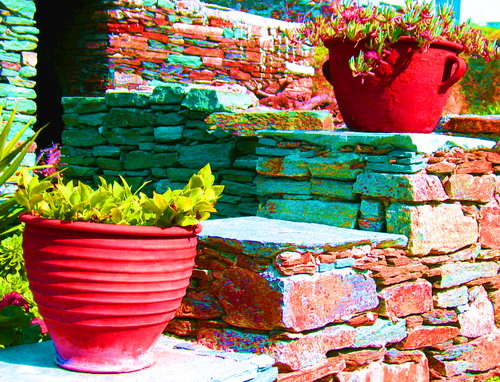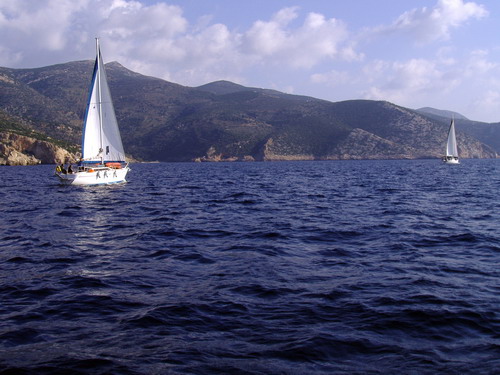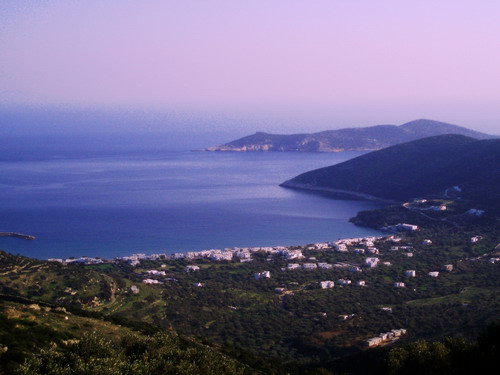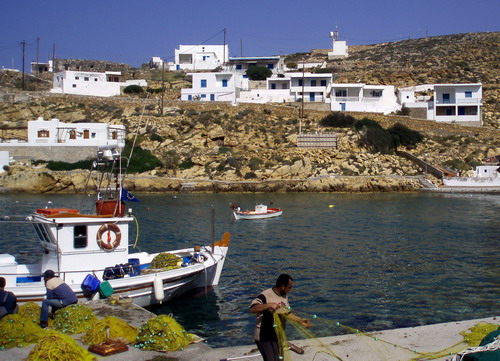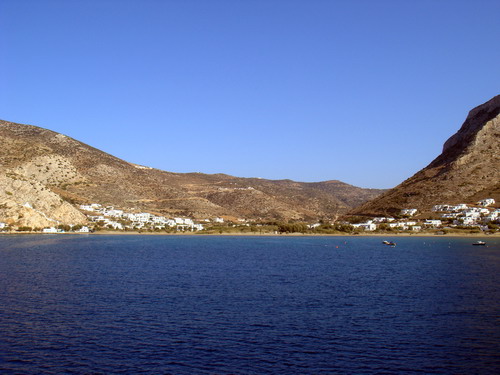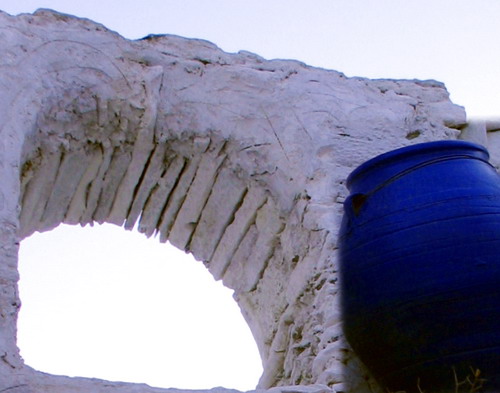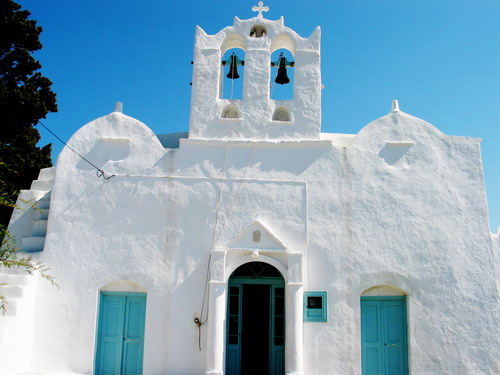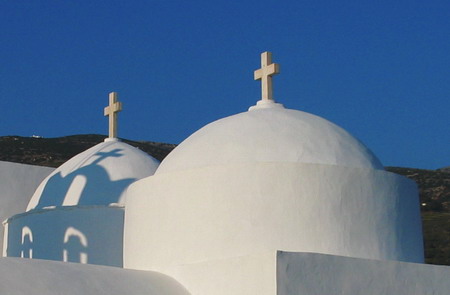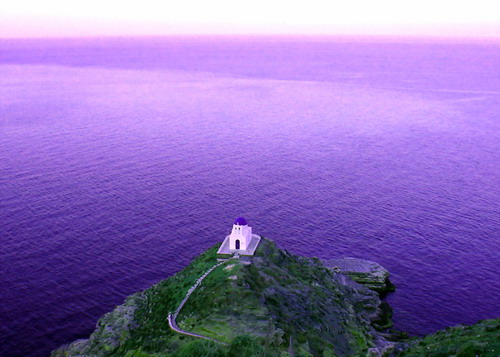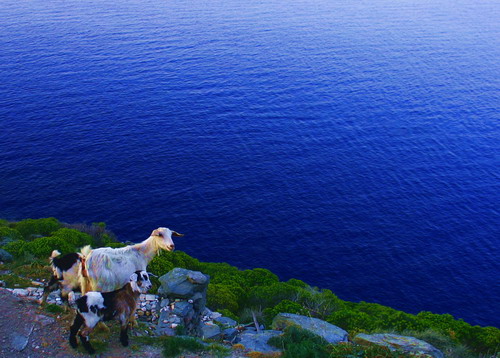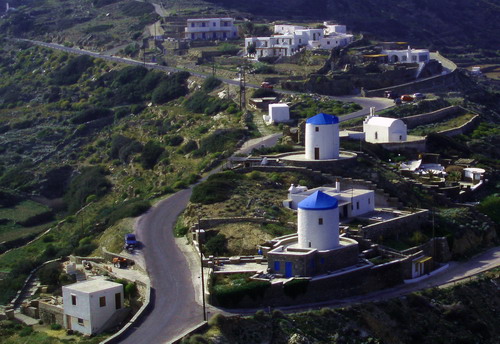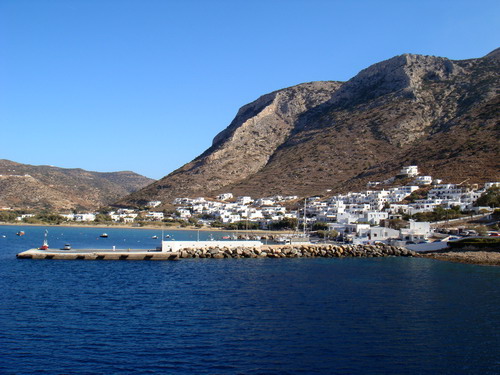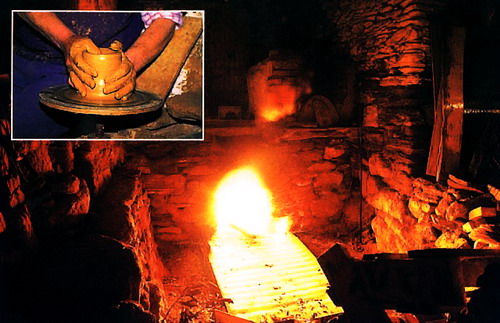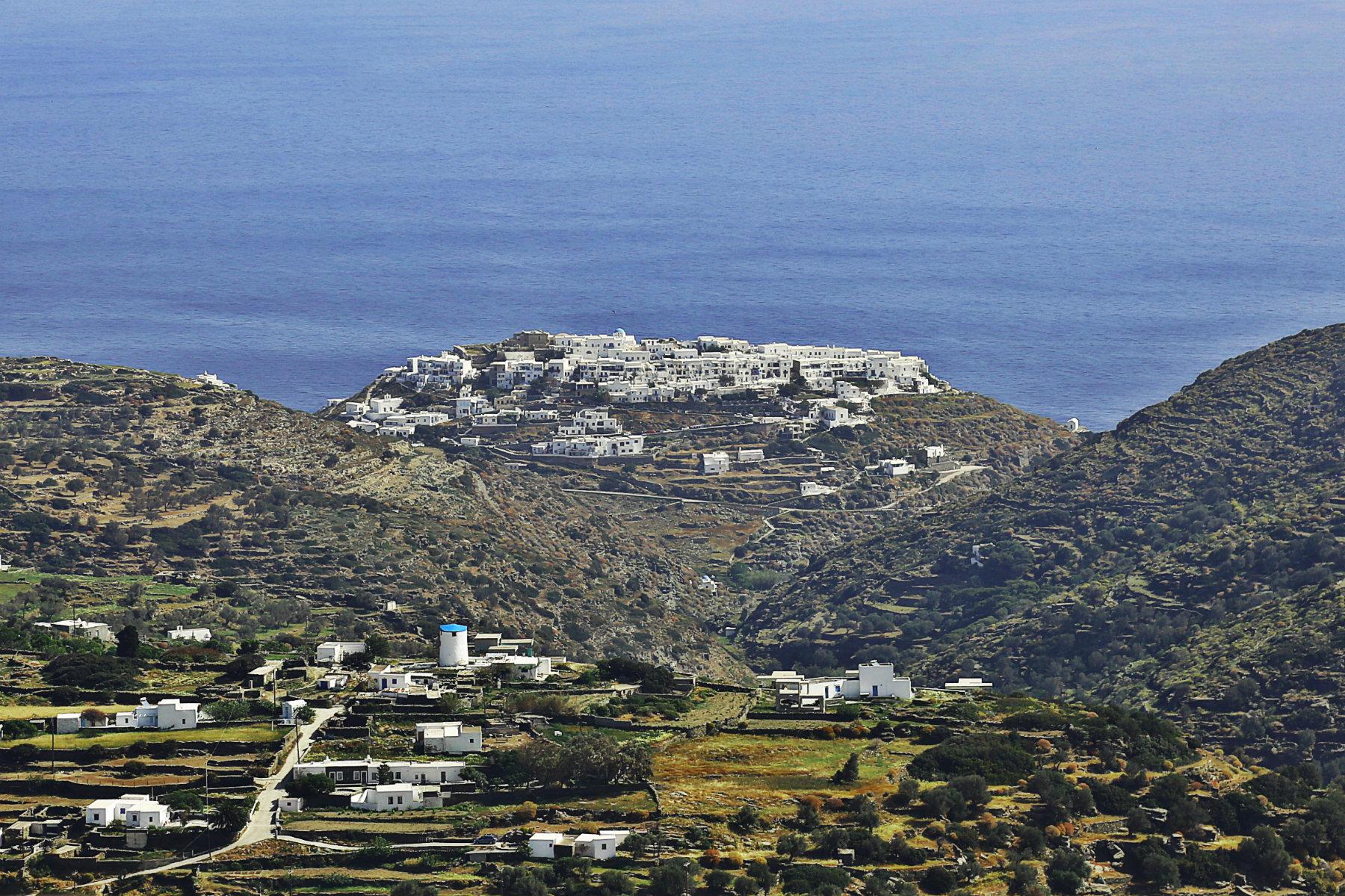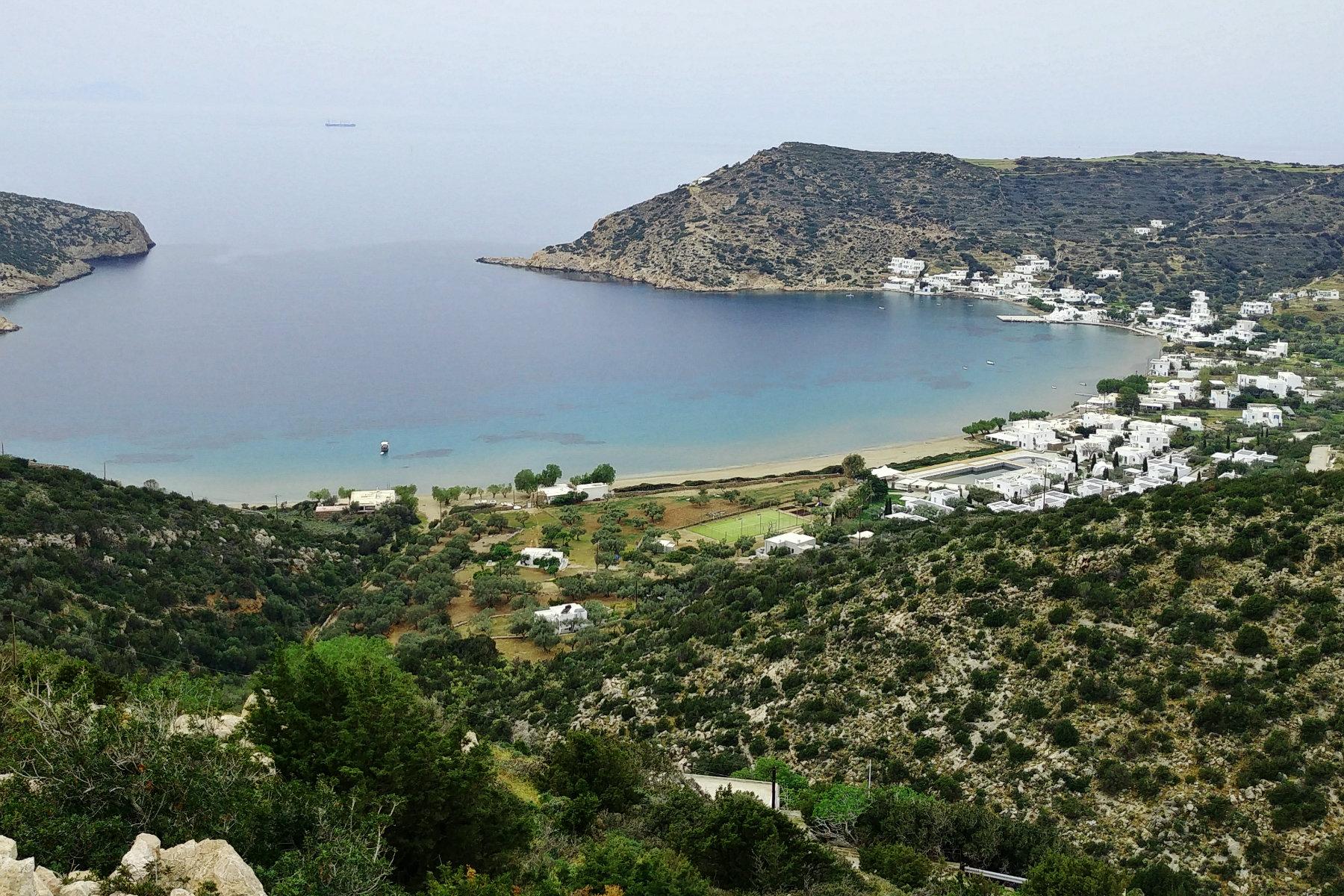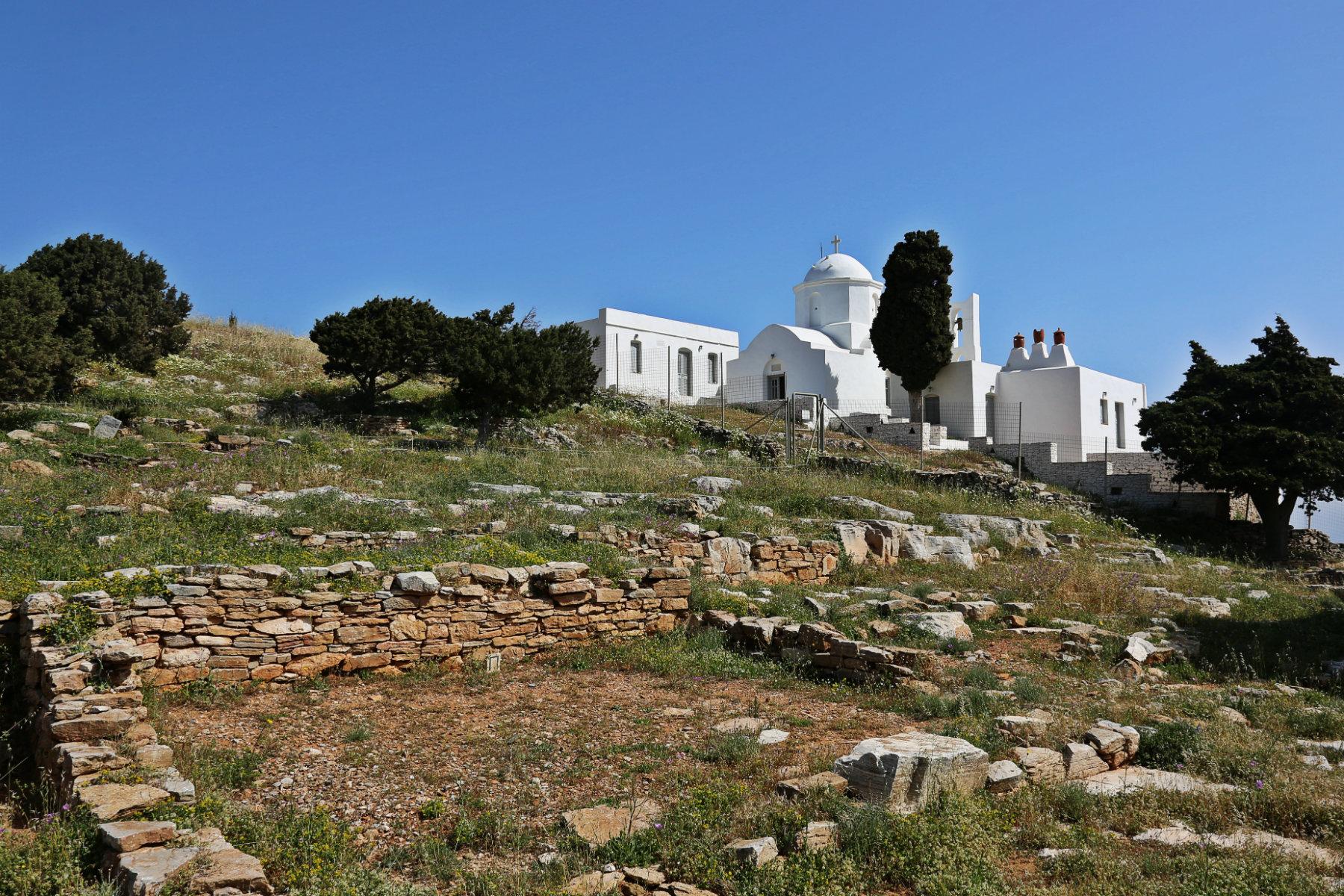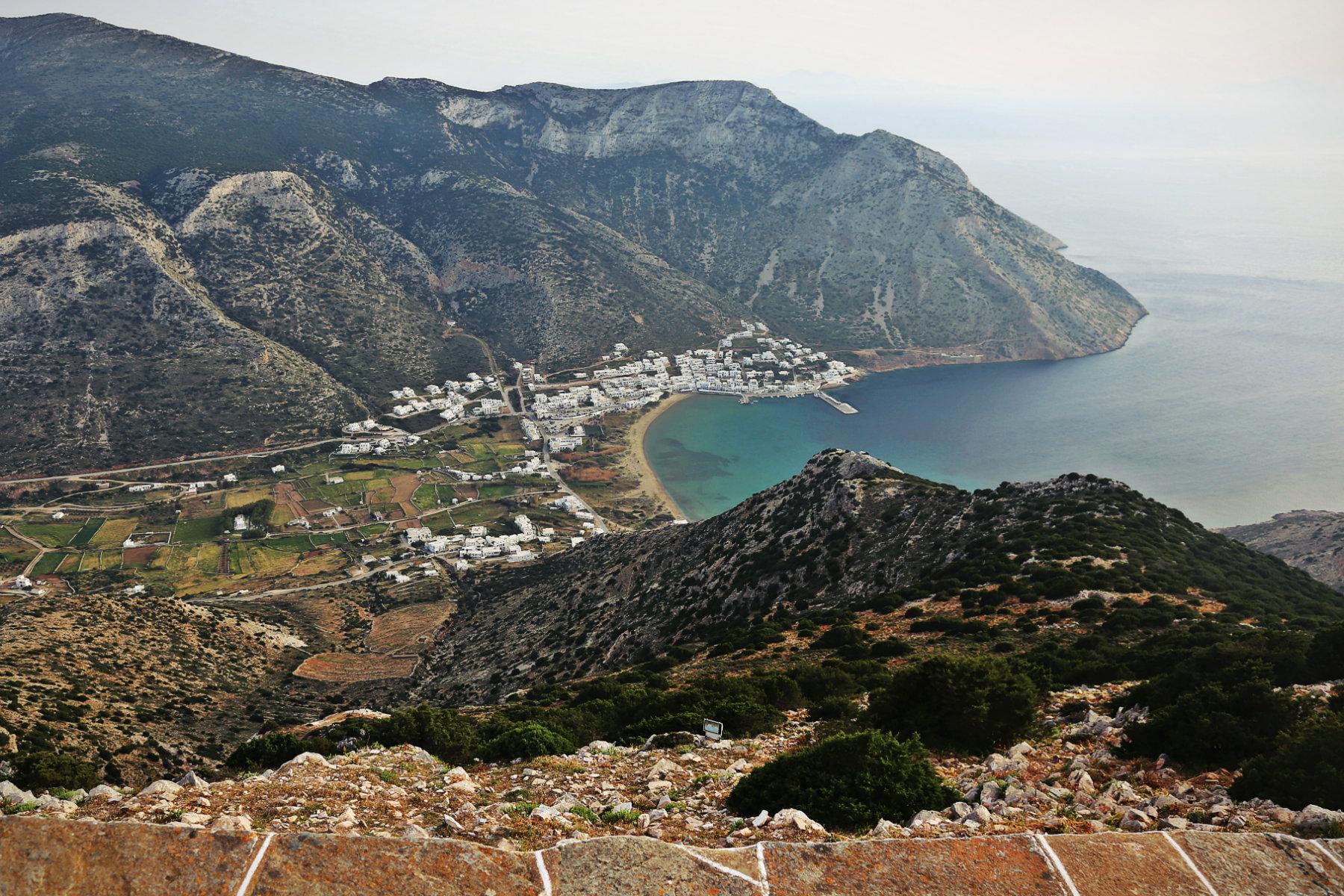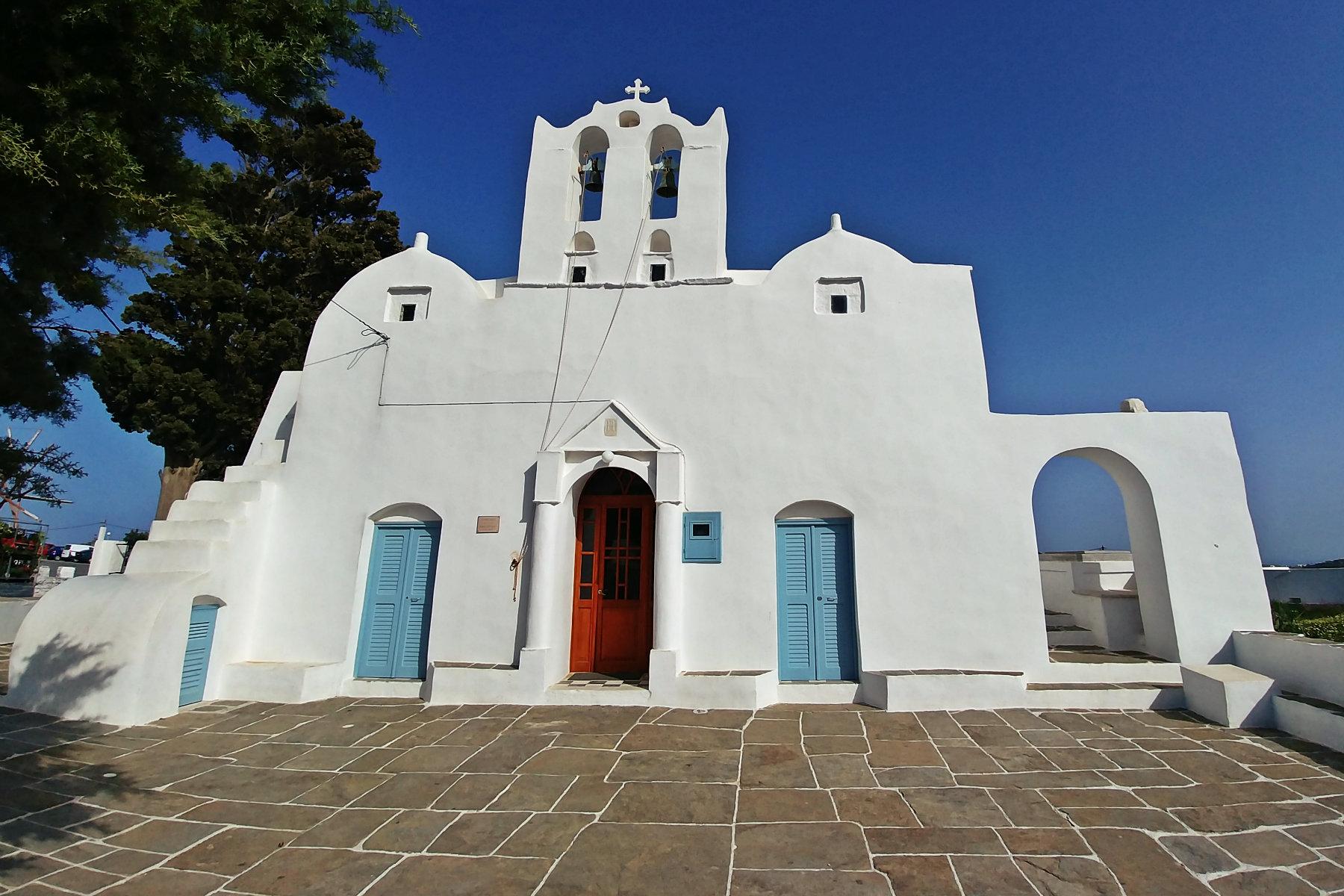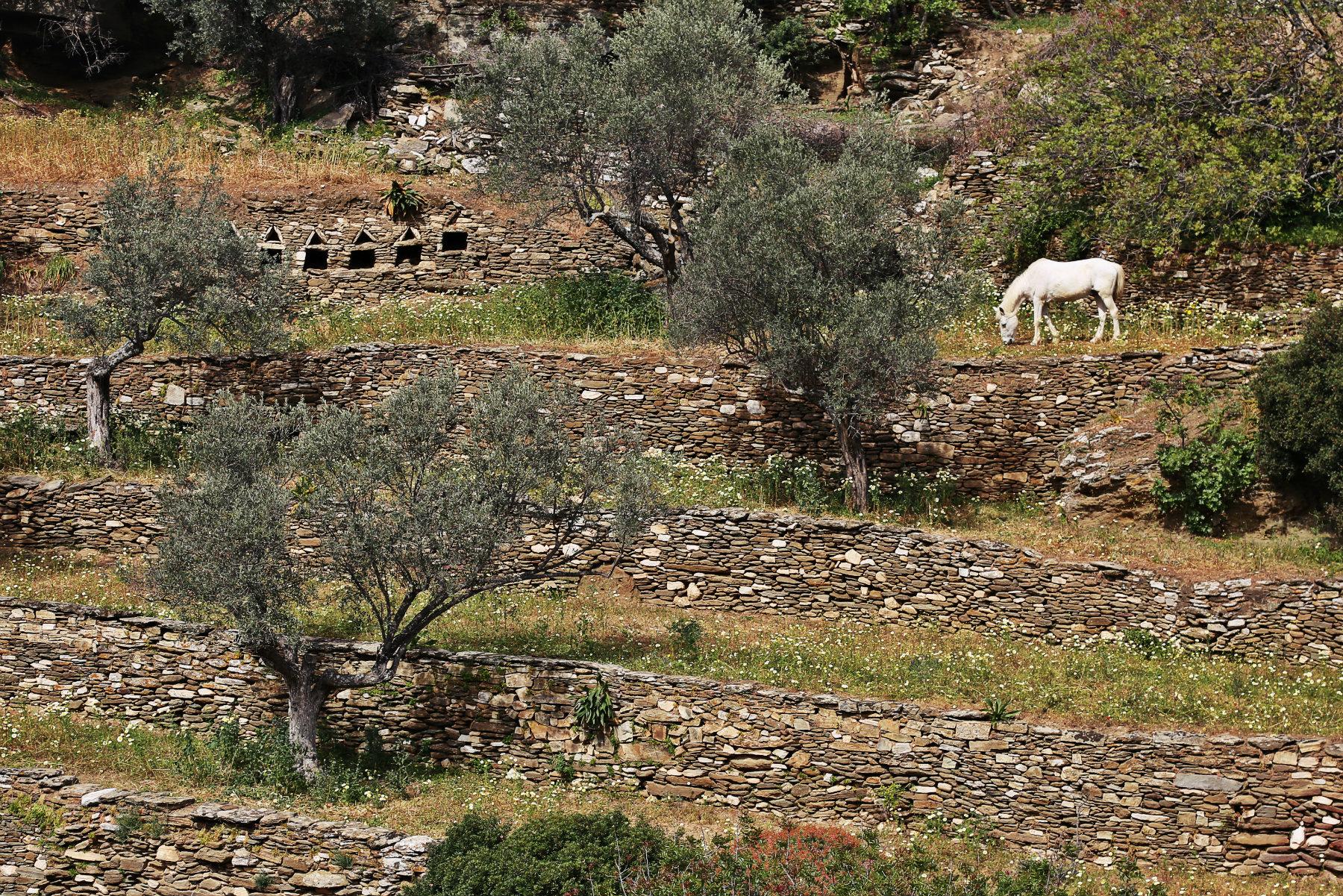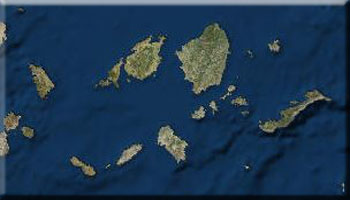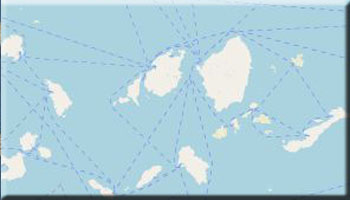Sifnos is part of the Western Cyclades, near Kimolos (10 nautical miles), Serifos (12 nautical miles), Paros (14 nautical miles), and Milos (20 nautical miles); it's 75 nautical miles from Piraeus. Shaped like a slightly elongated oval, it reaches 18 kilometers at its longest point on the north-south axis and 8 kilometers at its widest on the east-west axis. The island covers an area of 74 sq. kilometers, with a total shoreline of 28 nautical miles. In antiquity the island was known as Akis.
Sifnos's terrain is slightly rugged, rising to 680 meters at its highest peak, Profitis Ilias or Ai Niyias. Its coast is riddled with pretty coves with sand beaches, both open and sheltered as at Kamares, Platis Yialos, Vathi, Faros, Vlyho or Glyfo, and Fykiada. The uninhabited islet of Kitriani, where the 10th-11th-century church of Panayia Kitriani is located, sits just off Platis Yialos on the southeastern coast. The island has a population of 2,000 who engage in agricultural, stockbreeding, fishing, and ceramics - a craft for which the island is renowned. A large number of males are employed in the merchant marine and tourism also occupies a large segment of the population.
Local products include honey, wine, cheese, capers, figs, almond sweets, bourekia, almond cookies, bread rings, pastelli (nut and honey bars), honey pie, and, of course, ceramics and weaving. Sifnos is administered under the Milos Eparchy and the Cyclades Prefecture. The settlements at Apollonia and Artemonas, divided in 1914, have been reunited since 1999 under a single Municipality of Sifnos.
According to tradition, the island was named after Sifnos, son of the hero Sounion of Attica. At different periods, it has been known alternately as Akis (perhaps because of its pointed shape) and Merope (a reference to the daughter of Ariadne and Oenopas and granddaughter of King Minos of Crete). The name Sifnos has held since Frankish rule, with variants such as Sifounos, Sifanos, Sifano, Sifana, and Sifanta.
3000-2000 B.C.: Sifnos is inhabited by the Aegeans; evidence suggests mining activity on the island.
1130-1120 B.C.: The Ionians arrive on the island from Athens; it's believed they founded a city at the site of present-day Kastro.
8th-5th century B.C.: Sifnos flourishes thanks to its mining; the island mints its own coin.
525 B.C.: The Sifnians dedicate a treasury at Delphi.
5th-4th century B.C.: Sifnos takes part in the Battle of Salamis against the Persians.
388 B.C.: The island passes under Macedonian rule.
4th-3rd century B.C.: The royal physician Diphilos of Sifnos writes his book on nutrition and Malakos write his chronicle of life on Sifnos.
146-324 B.C.: Sifnos comes under Roman rule.
1207-1262: Sifnos is under Frankish rule.
1279-1307: Sifnos returns to Byzantine rule.
1537-1566: The pirate Barbarossa captures the island and submits it to Turkish rule. Its governed by the Gozzadini dynasty, under Turkish dominion, through 1617.
1617-1821: The island is governed by the head of the Turkish fleet, Capudan Pasha.
1642: Vassileios Logothetis, a wealthy merchant and commissioner, founds the Panayia Vrysiani Monastery.
1646-1797: Sifnos becomes the seat of an archdiocese with jurisdiction over eleven islands when the See of Sifnomilos is founded (1797-1852).
1650: A church dedicated to the island's patron saint, Panayia Chrysopiyi, is built over an ancient temple. The church, one of 230 on the island, remains active to this day.
1687-1854: Education reaches a peak with the founded of the School of the Holy Sepulchre, also known as the School of the Archipelagos.
1770-1774: Sifnos comes under Russian rule.
1821: A number of islanders claim prominent roles in the Greek independence revolt, among them Nikolaos Gryparis, Dimitris Lagos and Yoryios Baos. In 1821, Nikolaos Chrysogelos (1780-1857) raises the standard of the revolution over the Sifnos school; later he lands in the Peloponnese in the command of a contingent of 150 fighters.
1883: Kamares are established as the island's official port.
1914: The Municipality of Sifnos is split into the towns of Apollonia and Artemonas.
1941-1944: Sifnos is occupied by the Italians.
1999: A single Municipality of Sifnos is restored.
Kastro: The island's capital was located at Kastro from antiquity through 1836. The settlement was also the seat of the Archbishop of Sifnos from 1646 to 1797 and the Sifnomilos See from 1797 to 1852. Access to Kastro is through the old vaulted gates or loggias which were once protected by turrets. Kastro's streets and main square are built over the roofs of single-story dwellings, which are still used as warehouses. The homes chimneys were built perpendicular to the road and marked its path.
Kastro is still inhabited; there are a number of restaurants, pastry shops, and accommodations within its walls. Yialos or Seralia (from the Turkish serai or palace), the ancient port of Sifnos, is located at the southern foot of Kastro, where visitors can find accommodations and tavernas.
Churches - Monasteries: Several of the island's churches have been designated historic monuments because of their importance and architectural interest. Among them are the Panayia Angeloktisti at Katavati, the Monastery of Profitis Ilias Psilos, the Chrysostomou Monastery at Kato Petali, Panayia Gournia at Pano Petali, Ayios Antypas at Pano Petali, Ayios Konstantinos at Artemonas, Panayia tis Ammou and Panayia Konghi at Artemonas, Panayia Eleoussa at Kastro, the Panayia Poulati monastery, Panayia tou Vounou, and the Monastery of Panayia Chrysopiyi.
There are 227 churches on the island. Of special interest are the churches inside Kastro as well as the churches of Chrysopiyi, Panayia Vrysis, Moni Panayia Vounou, Angeloktisti Katavatis, Ayios Sozon, Panayia Konghi, Panayia Gournia, Panayia Ammos, Ayios Yioryis Afentis, Ayios Loukas, Ayios Konstantinos.
Ancient Fortifications - Old Mines: There are 55 ancient towers scattered around the island. The oldest date from the 6th century B.C. and the most recent were built in the 3rd century B.C., although only the Aspros Pyrgos survives in good condition. The towers were built after the Samians' raids and were used to relay messages to the ancient acropolises. Later the tower network was expanded to the entire island. According to Thucydides smoke and torches were used as signals.
Archaeological Museum: Exhibited at the archaeological museum in Kastro is a collection of Archaic and Hellenistic sculptures. The museum was renovated by the Culture Ministry in the early 1980s and has been fully restored since 1986.
Folklore and Popular Art Museum: Located on Iroon square in Apollonia, the folklore museum was established by the Sifnos Association to house a collection of artifacts linked to the island's traditions, from farming to household furnishings and local dress.
Museum of Ecclesiastic Art: The collection of ecclesiastic art is housed in the Moni Vrysianis and includes manuscripts, scrolls, and early editions, a Bible from 1796, relic cases, six-winged standards, chalices, icons, and an embroidered cloak.
Architecture: Settlements on Sifnos have a uniformity in their architecture. Kastro is laid out in a defensive pattern, easily discernible to visitors who wander its narrow lanes framed by marble reliefs and marked by vaulted passages or loggias that lead up towards the ruins of the central fortified section or castle. Most of the dwellings are two or three stories.
The island's traditional settlements are clustered in the interior, and over the years their boundaries have become blurred so that from some vantage points they seem to be part of a single, sprawling inhabited area. A paved walk runs from Artemonas, with its pretty mansions, through Ano Petali and Apollonia to Katavati, while another stone path links Artemonas to Ai Loukas, Exampela, Kato Petali, and Kastro.
The island's ceramics industry developed around coastal settlements which offer easy access to boats used to transport the wares.
Kamares: The largest coastal village, has also been the island's main harbor since the late 19th century. Facilities include travel and ferry agents, pastry shops, ceramics workshops, accommodations, car and bike rental agencies, newspaper vendors, an organized camping ground and dwellings. Development has spread across the bay from Kamares along the foothills of Ayios Symeon to the district of Ayia Marina or Pera Banta where there are accommodations and tavernas.
Platys Yialos: The island's most popular beach and one of the biggest in the Cyclades. Facilities include hotels and other accommodations, an organized camping ground, markets, tavernas, and ceramics workshops.
Vathi: As its name implies, is a harbor located at a lower altitude than the surrounding terrain. The beach and tranquil fishing village has become more accessible from sea and land since a dock was built and road laid. The Monastery of Taxiarhis tis Mersinis, founded in 1738, is about midway to Vathi. The imposing 17th century Evangelistria rises on the right end of the large, horseshoe-shaped bay. Facilities at Vathi include accommodations, market, tavernas, and ceramics workshop and showroom.
Faros - Chrysopiyi: Faros is located at the northeastern coast of Sifnos and is the island's most sheltered harbor (and was the main harbor until 1882). There are tavernas, a market, and accommodations. Faros is a quiet fishing village with picturesque sandy coves - Fasolou, Faros, and Glyfos. A footpath leads to Apokofto and Chrysopiyi. Ruins of a loading dock linked to the mines are visible in the bay's western crook.
Heronisos: On route to Heronisos the road passes the farm settlements of Troullaki, where there's a fine taverna, and Diavrouha, where there's a pottery workshop. Once isolated on the island's northern end, the fishing village is accessible in summer by boat. The village is part of the Artemonas complex; it's a quaint traditional fishing village arrayed along a small sand beach. Facilities include two fish tavernas, some accommodations, and a ceramics workshop.
Sifnos preserves old customs like the Paniyiras, local caroling, the Lolopaniyiros wedding, the dance of Kyr-Vorias, costumed carnival dances, and the pastos. Churches and chapels host a paniyiri, a folk celebration linked to the observance of a religious feast day, at least once a year.
These events include communal meals that trace their roots to the ancient "estiasi" and new year's day "agapes". Staple dishes served at these feasts are chickpea stew, meat with pasta or potatoes, and cod with potato salad, accompanied by local wine and followed by island music performed by violin and laouto.
During the peak summer season, festivals are held on the eve of the following religious feast days:
- The feast of the Ascension (May or June) at Chrysopiyi.
- Profitis Ilias on July 19.
- Ayios Pandeleimonas on July 26 at Heronisos.
- Ayios Symeon on August 31 and September 2.
- Taxiarchis on 5 September at Vathy
- Stavros on September 13 at Faros and Honi.
- Ayios Nikitas on September 14 at Seladi.
Easter falls in spring, when Sifnos is at its loveliest. All-night vigils are held at many churches as the somber mood builds to Good Friday and the Epitaphios, which is led in procession through each settlement. The Resurrection service is repeated over 40 days. Households prepare for Easter by baking the traditional "poulia", breads given the shape of various animals or birds and decorated with eggs dyed red. On Sifnos, the Easter lamb is slowly cooked in a clay "mastelo" or pot over dried vines in red wine flavored with dill or fennel. The local cheese, xinomizithra, is also served plain and combined with honey and eggs in a delicious cake known as melopita.
Other customs observed on the island are the burning of Judas in effigy, the "Lolopaniyiro" in February, the "Kyr-Vorias" dance on the last Sunday of carnival, and the Lenten "tsounia" (game).
| MUNICIPALITY OF SIFNOS | 2284360310 |
| INFORMATION CENTRE | 2284033661 |
| CITIZENS SERVICE BUREAU (KEP) | 2284033880 |
| POLICE STATION | 2284031210 |
| HARBOR POLICE | 2284033617 |
| MEDICAL CENTRE | 2284031315 |
| BUS STATION | 2284031977 |
| TAXI STATION | 2284031656 |









